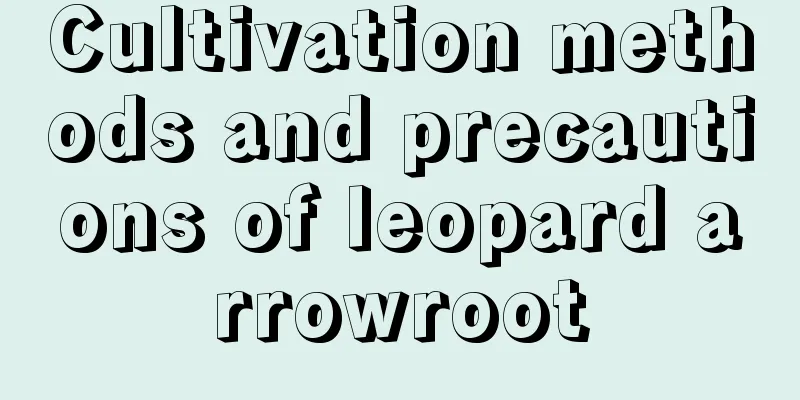Cultivation methods and precautions of leopard arrowroot

1. Maintenance methods1. Temperature: It is afraid of cold, so the breeding temperature should be controlled between 18 and 30 degrees, and the temperature in winter should be controlled above 10 degrees. The winters in the north are relatively cold, so it is not advisable to raise them outdoors. They must be raised indoors. There is heating in the north in winter. When the plants are overwintering, they should not be placed directly on the ground, but should be placed at a certain height from the ground. 2. Watering: It is suitable for growing in an environment with relatively moist soil. Therefore, in order to meet its living conditions, it needs to be watered every day. However, because the roots are not resistant to waterlogging, the amount of watering should be controlled each time. It is enough to water the soil until it is completely moist. There should be no water accumulation. 3. Fertilization: It consumes a lot of nutrients when growing, so it usually needs to be fertilized every other day. After the growth period, it only needs to be fertilized once a month. Fertilization needs to be done once before winter to ensure that nutrients are available during the winter. 4. Light: The growth of green plants cannot be separated from sunlight, and this plant is no exception. The daily sunlight must be guaranteed to be more than six hours. Except for appropriate shade in summer, it can receive full-day sunlight at other times. 2. Breeding techniques1. Reproduction: It can be propagated by division. The time for division should be chosen in spring, because the climate at this time is more stable and more suitable for its growth than other seasons. First, cut the root block with stems and leaves from the healthy mother plant, then bury the disinfected stem directly in the soil, and maintain the maintenance temperature at 20 to 28 degrees. Generally, new roots will grow in about ten days. 2. Pruning: Generally, it does not require pruning. You just need to pay more attention to it and deal with the rotten and dry branches and leaves. 3. Problem Diagnosis1. Pests: It is more susceptible to red spider mites. If the situation is not very serious, you can use insecticide to spray it. Spraying water mist on the back of the leaves more often can also play a certain preventive role. 2. Yellowing of branches and leaves: Yellowing of branches and leaves is mostly caused by excessive watering. Because of excessive watering, the roots of the plant cannot breathe normally, thus affecting the growth of the plant. To solve this problem, you should dig it out, trim off the rotten roots, and finally replant it in soil with better drainage. IV. Other issues1. Toxicity: non-toxic. 2. Edibility: It cannot be eaten directly. |
<<: Cultivation methods and precautions of Patrinia salsa
>>: Ivy cultivation methods and precautions
Recommend
How long does it take for Phalaenopsis to bloom? How long does it take for Phalaenopsis seedlings to bloom?
How long does it take for Phalaenopsis to bloom? ...
The difference between arrowleaf okra and okra
1. Difference of blades The leaves of arrowleaf o...
When is the best time to plant northern radish?
Planting time of northern radish In the northern ...
How to grow carnations at home
Can carnations be cultivated at home? Carnations ...
What fertilizer to use for blueberries
Blueberry cultivation conditions are relatively s...
Cultivation methods and precautions for potted osmanthus trees
Osmanthus trees prefer warm and humid environment...
How to fertilize calamus
Does calamus need fertilizer? Please don’t laugh ...
How often should I water the torch flower?
How often should I water the torch flower? Torch ...
What kind of soil is best for growing Desert Rose?
Desert rose is a drought-resistant and heat-resis...
How to grow geraniums so that they bloom out of the pot?
Geranium is a beautiful flower with rich colors, ...
How can we get high yield from growing potatoes?
Potato , as one of the important food crops widel...
How do potted daffodils survive the winter? Will daffodils be frozen to death in winter?
1. How to survive the winter 1. Maintain temperat...
How to germinate water lily seeds and how to plant them after germination
1. How do seeds germinate? 1. Seed cracking: Wate...
How to prune sea buckthorn
Pruning of young seabuckthorn trees First of all,...
Can aloe vera be placed in the bedroom?
1. Can it be placed in the bedroom? Everyone know...









